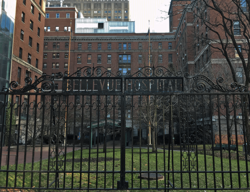Bellevue
Jump to navigation Jump to searchBellevue began as an almshouse in 1735, with an infirmary containing six beds to address the problem of "vagabonds and idle beggars" in New York City. It grew in fits and starts, expanding its role from a poorhouse to a pesthouse in response to yellow fever, small pox, asiatic cholera, puerperal fever, and — eventually in 1847 — typhus.
The physicians of Bellevue helped develop New York City’s sanitary code, the first city Morgue opened, and a hospital based ambulance system extended the reach of the institution into many corners of the island. Bellevue continued to physically grow as the needs of the city evolved, and in 1897, opened an Insane Pavilion to house and treat the mentally ill. The term "Bellevue" would soon become slang for any mental health facility
The psychiatric wing quickly became the police's dumping ground for the so-called criminally insane (such as Mark David Chapman and Edie Sedgwick). It also served as a revolving door for homeless patients, and by 1983, nearly all new admissions were re-admissions.
In 1981, when GRID appeared in New York, the city began phasing Bellevue out as a psychiatric center. This new plague changed Bellevue to such an extent that by the mid 80s, AIDS became the most common inpatient medical diagnosis. In 1985 the hospital had over four hundred AIDS patients, more than any other hospital in the country, and Bellevue sprouted an AIDS ward and outpatient program.
